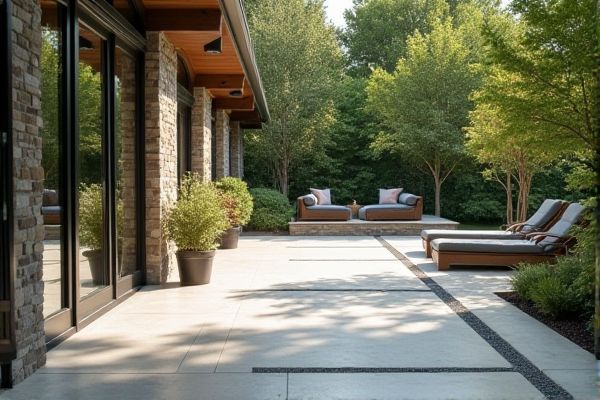
Tile decks offer a stylish, customizable surface with a variety of colors and patterns that enhance outdoor aesthetics, while concrete decks provide durability and low maintenance, ideal for heavy foot traffic and long-term use. Explore the rest of the article to discover which option best suits your outdoor living needs.
Table of Comparison
| Feature | Tile Deck | Concrete Deck |
|---|---|---|
| Material | Ceramic, porcelain, or natural stone tiles | Poured concrete with optional finishes |
| Durability | High resistance to weather, but can crack or chip | Very durable and strong, resistant to heavy loads |
| Maintenance | Requires periodic cleaning and grout sealing | Low maintenance; occasional sealing recommended |
| Installation | Labor-intensive; requires skilled tile setting | Faster; involves pouring and curing concrete |
| Cost | Moderate to high depending on tile quality | Generally lower; depends on finish and size |
| Slip Resistance | Varies; textured tiles enhance safety | Can be textured or treated for slip resistance |
| Aesthetics | Wide design variety with colors and patterns | Limited colors; versatile with stains and stamps |
| Climate Suitability | Best for mild to moderate climates | Suitable for all climates; handles freeze-thaw well |
| Repair | Individual tiles can be replaced | Cracks may need patching; less customizable |
Introduction to Tile Decks vs Concrete Decks
Tile decks offer a durable and aesthetically versatile surface ideal for outdoor patios and pool areas, featuring materials like porcelain, ceramic, or natural stone that resist moisture and temperature changes. Concrete decks provide a robust, cost-effective foundation with customizable finishes such as stamping, staining, or polishing to mimic more expensive materials while ensuring long-term structural integrity. Choosing between tile and concrete decks depends on your preferences for maintenance, design flexibility, and climate resilience.
Material Composition and Characteristics
Tile decks are composed of ceramic, porcelain, or natural stone tiles that offer high durability, water resistance, and a variety of design options. Concrete decks are made from cement mixtures combined with sand, gravel, and water, providing strong structural integrity and excellent load-bearing capacity. You can choose tile decks for aesthetic variety and smooth surfaces, while concrete decks excel in toughness and longevity under heavy use.
Aesthetic Appeal and Design Flexibility
Tile decks offer superior aesthetic appeal and design flexibility, allowing you to choose from a wide range of colors, patterns, and textures to create a personalized outdoor space. Tile materials such as ceramic, porcelain, or natural stone provide versatility in styles, enhancing the visual impact of your deck. Concrete decks typically have a more uniform appearance but can be customized with stains, stamps, or overlays for added design options.
Installation Process and Timeframe
Tile decks require a meticulous installation process involving waterproof membranes, thin-set mortar, and grout, which extends the timeframe to several days to weeks depending on drying times. Concrete decks have a faster installation, typically completed in a few days, including pouring, leveling, and curing that usually takes about 7 days for basic strength. Proper surface preparation and curing significantly impact the durability and longevity of both tile and concrete decks.
Durability and Longevity Comparison
Tile decks offer superior resistance to cracking and peeling due to their flexible installation over stable substrates, extending their lifespan up to 25-40 years with proper maintenance. Concrete decks provide robust structural strength but are prone to surface cracking and weathering, often requiring periodic sealing or resurfacing every 10-15 years to maintain durability. Both materials withstand heavy foot traffic, but tile decks generally excel in resisting moisture damage and UV exposure, enhancing their longevity in outdoor environments.
Maintenance Requirements and Costs
Tile decks demand regular sealing and grout maintenance to prevent water infiltration and potential cracking, with costs varying based on tile quality and repair frequency, typically ranging from $200 to $500 annually. Concrete decks require periodic cleaning and occasional resurfacing or sealing every 2-3 years to maintain durability and appearance, costing approximately $300 to $700 per maintenance cycle. Long-term maintenance expenses for concrete decks are generally lower than tile decks, making concrete a cost-effective choice for budget-conscious homeowners.
Safety and Surface Comfort
Tile decks offer a smooth, non-porous surface that can become slippery when wet, requiring textured or anti-slip tiles to enhance safety. Concrete decks provide a rougher texture that naturally improves traction, reducing slip hazards, and they can be finished with additives to boost surface comfort and grip. Both materials benefit from proper sealing and maintenance to ensure long-term safety and comfort for barefoot use.
Climate and Weather Resistance
Tile decks offer superior climate and weather resistance due to their ability to withstand extreme temperatures, moisture, and UV exposure without cracking or fading. Concrete decks, while durable, can be prone to cracking and spalling in freeze-thaw cycles and require sealing to maintain longevity. Choosing a tile deck can enhance your outdoor space's resilience and reduce maintenance in variable weather conditions.
Cost Analysis: Initial and Long-Term
Tile decks typically have a higher initial cost due to materials and labor for proper installation and waterproofing, while concrete decks are generally more affordable upfront. Over the long term, tile decks require periodic maintenance such as grout sealing and potential tile replacement, leading to moderate ongoing expenses. Concrete decks, although less costly initially, may incur higher maintenance costs related to cracking and resurfacing over time, affecting overall durability and expense.
Choosing the Right Deck for Your Needs
Tile decks offer a stylish, customizable surface with excellent durability and slip resistance, making them ideal for poolside or outdoor living areas where aesthetics and comfort matter. Concrete decks provide a cost-effective, low-maintenance option with superior strength and longevity, suitable for heavy usage and varied weather conditions. Your choice depends on balancing aesthetic preferences, budget, and the intended use of the deck space.
 homyna.com
homyna.com